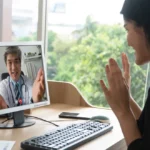Integration of RPM with Electronic Health Records (EHRs)

Over 85% of hospitals in the US have adopted Electronic Health Records (EHRs), yet many still struggle with real-time patient data integration. Remote Patient Monitoring (RPM) bridges this gap, enabling 24/7 access to vital health data and improving patient outcomes.
In recent years, technological advancements in the medical field have greatly improved how providers deliver care and consultation to chronic patients. One of the most innovative transformations is the inclusion of RPM and its integration into electronic health records. This integration not only provides healthcare providers with the convenience of monitoring their patients any time of the day, but also enhances patient outcomes and reduces healthcare costs.
In this blog, we’ll explain in depth the role played by RPM in healthcare, the benefits of integrating it with EHRs, and its future scope.
Table of Contents
ToggleWhat is Remote Patient Monitoring (RPM)?
Remote Patient Monitoring is a technology used to monitor patients outside of the usual in-clinic settings. It allows healthcare providers to collect patient’s health data, including blood pressure, heart rate, glucose levels, oxygen saturation, and even activity levels remotely using wearable devices, sensors, cellular medical devices, and other compatible technologies.
Modern RPM devices, such as AI-powered wearables, continuous glucose monitors (CGMs), and smart ECG patches, seamlessly integrate with EHRs through FHIR and HL7 compliance. This ensures smooth data exchange and reduces manual entry errors.
An RPM system converts and generates reports of this real-time data that is used by providers to make informed decisions and timely interventions. RPM, along with Chronic Care Management (CCM) is proactively helping in managing chronic diseases, post-surgical recovery, and care outcomes for patients dealing with multiple conditions, like diabetes, hypertension, heart diseases, COPD, and others, where continuous check-ups and interventions are needed to ensure patient progress.
Now that we’ve covered how RPM enables real-time health tracking, let’s explore how EHRs store and manage this data to improve provider workflows and patient care.
What is an Electronic Health Record (EHR)?
An Electronic Health Record (EHR) is a digital record that consists of a patient’s medical history and is maintained by healthcare providers. It includes complete details about patients, as well as their outcomes, such as diagnosis, treatments, allergies, medications, test results, and treatment plans.
One of the objectives of EHRs is to bridge the gaps in healthcare settings, such as hospitals, specialty clinics, pharmacies, and primary care offices, so that everyone involved in patient care can easily find and retrieve accurate and up-to-date medical information.
Most of the leading EHR systems are designed to reduce errors, provide efficient care, and improve communication among care providers. On technological front, they help track outcomes and generate insights into the quality of healthcare delivery model.
Benefits of Integrating RPM with EHRs
According to a study by the American Hospital Association, RPM integration with EHRs reduces hospital readmissions by up to 38% and improves chronic disease management outcomes by 25%. With real-time data available in EHRs, providers can act proactively and prevent emergencies. There are so many benefits of integrating RPM with top EHRs, and some of the most prominent ones include:
- Better Patient Care and Outcomes: Integrating RPM with EHRs enables real-time patient monitoring, ensuring accurate diagnoses and timely interventions. The detailed records enable healthcare providers to detect problems before they turn critical and allow them to make timely interventions to avoid emergencies.
For instance, a patient suffering from hypertension that is under remote monitoring would have their blood pressure readings being continuously monitored and updated in the EHR system. If there is a sudden spike in blood pressure reading, the health provider can act quickly to change medications or recommend lifestyle changes.
Not only this, RPM-EHR integration delivers personalized care wherein healthcare providers can review the health data of a patient over time and plan a personalized course of treatment after understanding their health trends and needs.
- Prevents Hospital Readmissions: Remote patient monitoring is playing an effective role in monitoring the patients from the comfort of their homes, thereby deviating them from hospital or in-clinic visits. By allowing caregivers to act early and make modifications in the treatment plans, RPM helps reduce the risks of immediate hospitalizations or readmissions.
For instance, a patient recovering from surgery is monitored for possible signs of infection, complications, or other health issues that may lead to hospitalization via an RPM system. This early detection allows providers’ to effectively manage patient care and reduce both hospital readmissions and healthcare costs.
- Advancement of Care Coordination: With RPM data becoming part of the electronic health records, healthcare providers can seamlessly coordinate among themselves to use the data they need, without having to go through patient’s manual records and prescriptions. An efficient EHR system makes access to real-time health information possible for all care members, whether primary care physicians, specialists, or nurses. This improves communication and ensures that everybody is on the same page about the patient’s condition and course of treatment.
For instance, a patient might already be seeing different specialists because of multiple chronic conditions. With all RPM data being shared through EHRs, any specialist the patient visits or consults can access the EHR to have access to real-time information about patient’s health status, thereby preventing treatment conflicts or medication errors.
- Empower Patients with Access to Health Data: The integration of an RPM platform and an existing EHR system provides healthcare providers with a quick view and better access to their patient’s health data. Some EHR systems provide online portals for even patients to access their health information, view lab results, track health metrics, and communicate with healthcare providers. When integrated into these systems, RPM allows patients to see real-time updates on their health progress and keep them actively involved in self-care.
This transparency boosts self-engagement among patients, compel them to make informed health choice, and ensure adherence to the medication plan.
- Ensures Cost Efficiency: By integrating RPM with EHRs, healthcare expenditures can be minimized to a great extent. With a reduction in in-clinic patient visits, and providing the healthcare providers with the convenience of monitoring their patients from anywhere and anytime, providers can save on time, resources, burden, and costs.
In addition, RPM integration with an electronic health record can help in the early identification of health issues and generate significant savings for healthcare providers and patients over time.
The Future of RPM and EHR Integration
The future outlook for the RPM and EHR integration is bright for healthcare organizations and physicians focused on more precise care and actionable insights. Artificial Intelligence (AI) and Machine Learning (ML) advancements will play a vital role in analyzing large data sets generated by RPM systems.
As RPM-EHR integration continues to evolve, providers should prioritize solutions with AI-driven automation, predictive analytics, and seamless interoperability. Future-ready platforms like HealthArc ensure compliance and workflow optimization, making it easier for healthcare organizations to adopt modern care models.
Being a leading RPM platform, HealthArc seamlessly integrates with 20+ EHRs and 40+ medical devices with robust device connectivity. The integration is focused on providing a unified communication platform and a streamlined clinical workflow for healthcare providers. Being HIPAA and SOC2 compliant, HealthArc ensures the highest standards of data security and patient privacy.
Conclusion
- Unified Data: Centralizes patient information.
- Improved Coordination: Facilitates team collaboration.
- Better Efficiency: Reduces manual data entry.
- Compliance: Ensures HIPAA‑aligned processes.
- Enhanced Care: Enables informed, timely interventions.
Schedule a demo to learn more about how our RPM system can integrate with your existing EHR system or call us today at +201 885 5571 to set up a consultation with our experts.
Frequently Asked Questions (FAQs)
EHR integration improves remote patient monitoring effectiveness through the spatialization of patient data. It ensures the RPM data stream is delivered to the documentation seamlessly and in real time. This allows proactive, fully informed, and documented decisions to be made, which ensures compliant, stratified, and multidisciplinary care.
Through the RPM integration with EHR, the silos of separated patient data are breached, which improves data continuity. This provides unrestricted access to documents like vital signs, progress notes, treatment updates, and other important patient data, which improves provider-to-provider communication.
Other than the more common data types of RPM and EHR systems not operating seamlessly, other concerns like data safety, higher system purchase, and strict employee training all present as hurdles to achieving smooth and safe integration. Navigating these challenges is essential for overcoming the more common ones.
An RPM platform to be fully EHR integrated should include instant data syncing, data interoperability with FHIR, data of all types security, configurable system dashboards, and proactive warning systems. All these features enhance streamlined workflows and improve the quality of care.
The integration of EHR and RPM systems eliminates the need for manual data entry, automates processes, and reduces the creation of overlapping records. Integrated and streamlined workflows ensure that practitioners have quick access to consolidated patient information, which in turn saves time and minimizes errors, allowing practitioners to concentrate on delivering care rather than on administrative tasks.
Most Recent Blogs
Categories
Related Blog
- November 26, 2025 | Read Time: 14 mins
Return on Investment (ROI) of Remote Patient Monitoring (RPM): A Complete Guide for ACOs and Healthcare Organizations
The U.S. healthcare system continues its transition from fee-for-service models to value-based...
Learn More- November 24, 2025 | Read Time: 15 mins
Common RPM Pricing Models for Providers: A Profitability-Focused Guide
Remote Patient Monitoring (RPM) has rapidly emerged as one of the leading...
Learn More- October 23, 2025 | Read Time: 12 mins
How RPM Devices Improve Hypertension and Diabetes Outcomes in Medicare Populations
Remote patient monitoring (RPM) is transforming chronic care for Medicare beneficiaries. CMS...
Learn More


